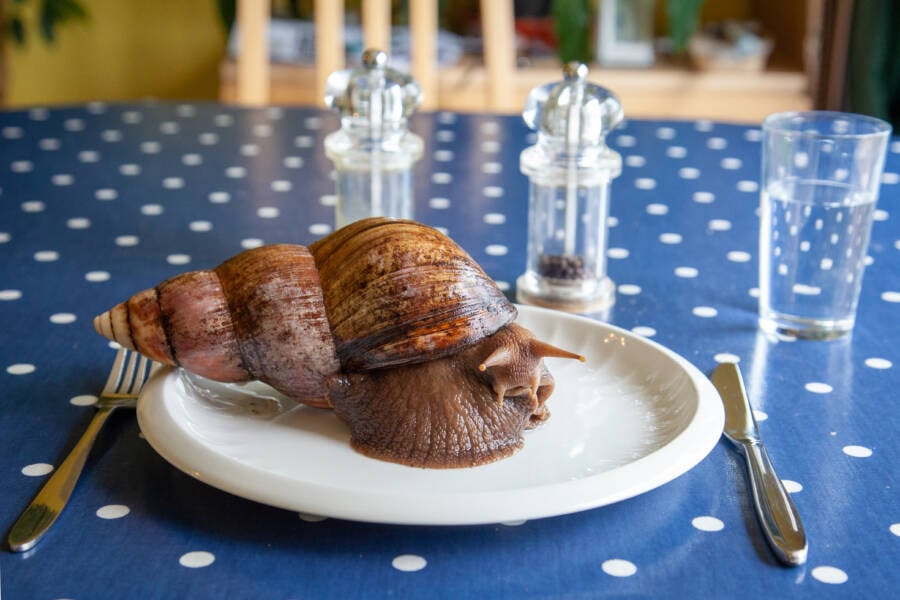Previous research suggested humans began regularly eating snails at the end of the last Ice Age, but new evidence shows the practice may have been put in place much earlier.

Peter Meade/Getty ImagesA Giant African Land Snail on a dinner plate.
Broken shell pieces found in a South African cave just provided researchers with the earliest evidence of humans eating snails, according to a new paper published in the journal Quaternary Science Reviews.
An analysis of the shell fragments excavated at South Africa’s Border Cave showed signs that the shells had been heated, possibly in cooking, leading researchers to conclude that ancient humans had been roasting and eating snails longer ago than previously thought.

Past research revealed evidence of humans eating snails around 49,000 years ago in Africa and 36,000 years ago in Europe, but this new find suggests that humans may have begun dining on the mollusks 70,000 to 170,000 years ago.
“The easy-to-eat, fatty protein of snails would have been an important food for the elderly and small children, who are less able to chew hard foods,” study author Marine Wojcieszak of the Royal Institute for Cultural Heritage in Brussels told Science News.
What’s more, prior to this study, researchers believed humans only made land snails and other small game a regular, significant part of their diet near the end of the last Ice Age, 15,000 to 10,000 years ago. But this new evidence shows that humans understood the nutritional value of land snails far earlier than previous assumptions suggested.

iStock/Getty ImagesGiant land snails would have offered easy-to-eat, high protein meals for ancient humans.
South Africa’s Border Cave, a rock shelter on a cliff roughly 2,000 feet above sea level, has provided researchers with a wealth of knowledge about how ancient humans lived. Previous excavations have uncovered evidence of humans eating mussels, limpets, and other marine mollusks as far back as 164,000 years ago.
The cave has also shown that ancient humans cooked starchy plant stems, ate a variety of fruits, and hunted large and small animals, and is the site of the oldest known grass bedding, dating back 200,000 years.
These previous discoveries prompted the new investigation, in which researchers uncovered a litany of shell fragments ranging in color from beige to brown and gray. These color variations indicated that the shells may have been cooked, as a shell’s color can change when exposed to heat.
To confirm this theory, researchers warmed pieces of modern giant land snail shells to temperatures ranging from 392 degrees Fahrenheit to 1,022 degrees Fahrenheit for varying lengths of time, from anywhere between five minutes to 36 hours. In their observation, they saw the shells’ color change and also noted weight loss, microscopic cracks, and changes to the shells’ chemical balance.
It is, of course, possible that the shells had been accidentally heated by a fire, but bits of other food including charred seeds and animal bones nearby suggested to researchers that these items were intentionally cooked, Wojcieszak explained to New Scientist.
According to the team, invertebrate animals like snails make up more than 95 percent of Earth’s biodiversity but are often overlooked in archaeological research for a number of reasons.
Chiefly, these animals are frequently considered to be unimportant when it comes to understanding the behavior of ancient humans, but their size and makeup also mean that finding evidence of their presence hundreds of thousands of years down the line is extremely difficult. Snails are an exception to this latter point, however, due to their shells.
“Terrestrial mollusks are an excellent source of nutrients,” the authors wrote. “They are easy and not dangerous to collect, they can be stored for some time before being consumed, they are simple to prepare and to digest as long as one has a basic mastery of fire.”
Though snails and invertebrates like them have largely been ignored in the context of human history, this new discovery shows not only that they were a crucial component of human sustenance, but that they also influenced ancient humans’ social dynamics. Evidence of ancient humans eating and sharing snails suggests that “cooperative social behavior was in place from the dawn of our species,” Wojcieszak said.
After learning about this new insight into ancient humans’ eating habits, learn about ancient humans’ sex habits and how they bred with the mysterious race of Denisovans. Or, see what this 45,000-year-old bone taught us about human-Neanderthal relations.





